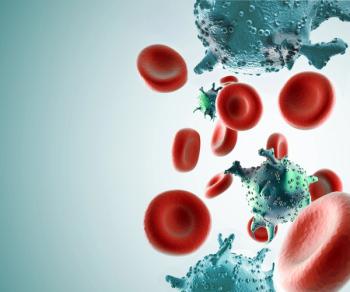
- Oncology Vol 28 No 1S
- Volume 28
- Issue 1S
(P041) Dosimetric Predictors of Hypothyroidism Development in Oropharynx Cancer Patients Treated With IMRT
Radiation therapy delivered to the lower neck has long been associated with an increased risk of subsequent development of hypothyroidism. The purpose of this study was to define dosimetric predictors of increased hypothyroidism risk for oropharyngeal (OPC) patients treated with intensity-modulated radiation therapy (IMRT) to be used to guide treatment planning.
Josephine Chen, PhD, Arthur Chyan, BA, Erin Shugard, MS, Louise Lambert, MD, Jeanne Quivey, MD, Sue S. Yom, MD, PhD; University of California, San Francisco; Centre Hospitalier de l’Universite de Montreal
Purpose: Radiation therapy delivered to the lower neck has long been associated with an increased risk of subsequent development of hypothyroidism. The purpose of this study was to define dosimetric predictors of increased hypothyroidism risk for oropharyngeal (OPC) patients treated with intensity-modulated radiation therapy (IMRT) to be used to guide treatment planning.
Materials and Methods: In a retrospective study of patients treated at a single institution with conventionally fractionated IMRT, 123 patients with confirmed thyroid status were analyzed. Patients were categorized as hypothyroid if diagnosed with hypothyroidism by the attending physician or if laboratory test results showed elevated thyroid-stimulating hormone (TSH) levels. Univariate analysis was performed, comparing the hypothyroid with the euthyroid patient groups. Along with patient demographic parameters, thyroid volume, mean thyroid dose, the percent of thyroid volume receiving at least various levels of dose (VxxGy [%]), and the residual absolute thyroid volume receiving less than various levels of dose (resVxxGy [cc]) were analyzed. Kaplan-Meier curves for freedom from hypothyroidism and the log-rank test were used to compare subgroups of patients. The frequency of hypothyroidism observed in the study was compared with predicted outcomes for several literature-proposed Normal Tissue Complication Probability (NTCP) models using the Hosmer-Lemeshow test.
Results: At time of analysis, median follow-up was 4.6 years, and 61% of patients had developed clinical or subclinical hypothyroidism. Under univariate analysis, none of the demographic variables was statistically different in the euthyroid and hypothyroid groups, but thyroid volume and many of the dosimetric parameters were significantly different. Patients with initial thyroid volumes of less than 8 cc experienced very high rates of hypothyroidism in this study, with an estimated risk of hypothyroidism of 75% 3 years post-RT. In a subanalysis of the patients with thyroid volumes of 8 cc or greater, patients with resV45Gy of at least 3 cc, resV50Gy of at least 5 cc, resV50Gy of at least 6 cc, V50Gy below 45%, V50Gy below 55%, or mean thyroid dose below 49 Gy demonstrated significantly lower rates of hypothyroidism development than their counterparts on a log-rank test. At 3 years post-RT, the patients in the lower-dose groups had a 30% to 38% estimated risk of hypothyroidism compared with a 55% risk for the entire study group. Although there was some qualitative agreement between the hypothyroidism rates observed in this study with the rates predicted by various NTCP models, all comparisons showed a lack of fit using the Hosmer-Lemeshow test.
Conclusion: In a large retrospective review of 123 patients treated with definitive IMRT for OPC, a significant reduction in hypothyroidism rates at 3 years post-RT was found for patients with initial thyroid volumes over 8 cc and at least 3 cc of thyroid-spared radiation doses of 45 Gy or more. Similar patient stratification was obtained using related dosimetric parameters and thresholds, such as mean thyroid dose less than 49 Gy. To reduce the risk of hypothyroidism in these patients, it is recommended that IMRT optimization objectives be used to reduce the volume of thyroid receiving 45 Gy.
Articles in this issue
Newsletter
Stay up to date on recent advances in the multidisciplinary approach to cancer.

















































































